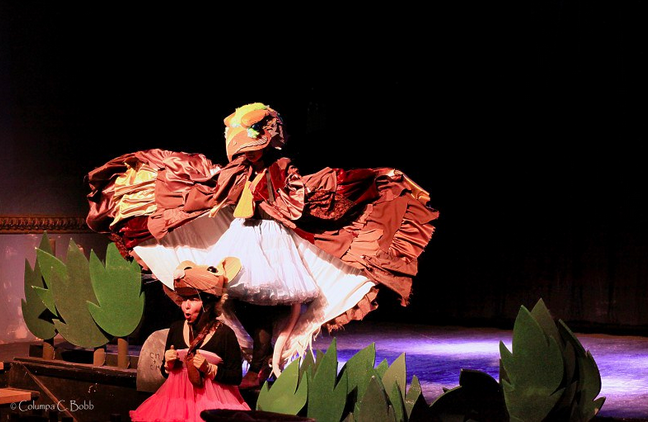Micro-Universes and Tabletop Tales: Canadian Theatre for Early Years
Over the last seven days I have learned about how to create a safe space for parents and children; I’ve learned how to trust my child to roam; I’ve learned that sometimes in Theatre for Early Years, kids vomit into cellos.
On a personal level, I’ve learned that my son will sit through any piece of theatre if there is live music involved – especially a violin. And I’ve learned to trust his ability to engage with challenging theatre, even though he is still a baby. I also learned that if and when he decides that he doesn’t want to sit still for 30 minutes in a dark theatre, that’s okay too. And that the other parents in the theatre will have their hearts go out to me while I briskly bundle up my child and exit. No hard feelings.
My own learning reflects the learning going on throughout the festival, whether inside the walls of the industry conference, or at the café in the Theatre Centre after the shows where parents chitchat and share knowledge. The learning extends, of course, to the children who witnessed some fantastic domestic and international art; and to the artists themselves.
As we look to the future of what we’ve all taken away from this festival, I want to turn our attention to the Canadian artists in the festival. They are the future of Theatre for Early Years in this country.
Pekka, by Le Théâtre des Petites Âmes in Québec, was a solo show featuring Isabelle Payant and a coterie of tiny puppets. Performed sometimes in English and sometimes in French, this play took its audience on a mythical journey with one of the smallest protagonists I’ve ever seen: Pekka. Pekka was the size of Payant’s hand, slipping in and out of its shell like a bracelet. In search of the moon, Pekka meets a variety of helpers along the way, all portrayed by very tiny puppets. This micro-universe was captivating to the children, who were leaning in to see what would happen next.
Tree/Arbre & Inuksuk, from Le Chemin qui Marche in Québec, was working on a similar scale as Pekka. This piece took place on top of a table, where artists Pierre Bérerd and Bénédicte Guillon Verne would conjure fantastical settings for very tiny puppets to inhabit. There were puppets the size of hands, but also the size of fingers. Again, you had to lean in to catch the action – and you wanted to, because the mise-en-scène was so magical. The performers take a single tree through its entire lifespan in front of your eyes. You see it being born, you see the role it plays in the happiness of various people, and then you see it die. The performers were so focused on their craft I found myself torn on where to look: I wanted to look at their creation because it was so spectacular, but I also wanted to watch their concentration and the tenderness with which they constructed the images.
Tabletop Tales, from the SNAFU & The Snack Music Collective, continues on this trend of creating big stories from small things. The artists ask the audience to share stories from their own lives, and then they use tiny household items to animate that story. They even compose a live score on the spot! The first incarnation of this show was at the Next Stage Theatre Festival in 2015, where WeeFestival Artistic Director Lynda Hill saw a performance. She told me that she was interested in it right away. She thought it would be great for families. Since then, the company has been working with Lynda and the WeeFestival to adapt the show for an audience of children. To me, this is such a great success story. To see a company make this jump into Early Years Theatre is very exciting – and especially one that is being mentored and advised by a leading voice in the field. In my opinion, if Canada is going to be able to foster a Theatre for Early Years scene, this sort of mentorship is essential.
Finally, I want to close by talking about Jumping Mouse, from Urban Indigenous Theatre in Manitoba. This show is a modern adaptation of a traditional indigenous story wherein a curious mouse sets off on a brave journey to the Sacred Mountains. Although this play drew upon some recognizable aspects of children’s theatre (colourful props and larger-than-life characters) the message was remarkably mature. I found this dichotomy very powerful: a bright set and fun music juxtaposed against a very profound story. I think it helped the kids open up and engage with the material.
Urban Indigenous Theatre is an incubator for the next generation of Aboriginal theatre artists and administrators. Listening to Columpa Bobb, their Artistic Executive Director, speak at the WeeFestival industry conference one day, I was so glad to have her voice in the room. It was a reminder of how segregated the storytelling in our nation can be; how essential it is that we, as curators, as parents, as artists, seek out the stories that define who we are as a collection of nations. Because it is these stories, especially when offered to our very youngest audiences, that will help break segregation and move us further along our collective journey of reconciliation.
It has been a pleasure sharing my thoughts with you over the course of this festival. See you at the theatre!

Still from Jumping Mouse
